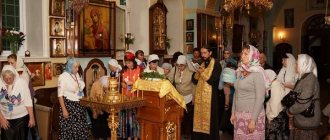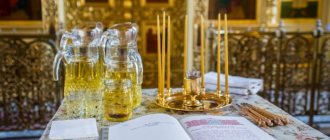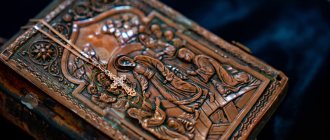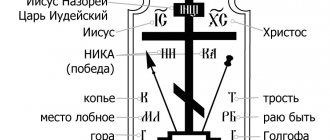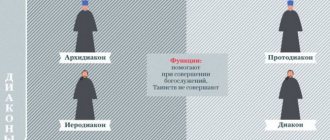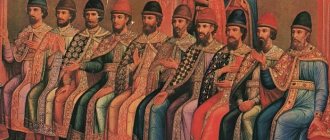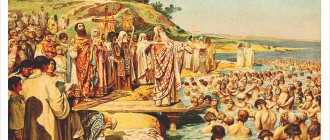How can you celebrate Communion at home?
To make Communion, you do not need to wait until they are allowed to attend churches. It is enough to invite the priest home, and he will perform the Sacrament. At home, clergy fulfill various requirements: they confess, administer communion, perform unction, and perform commemorations for the dead.
We publish the e-mails of the rectors of the churches of the Resurrection District. We recommend that you describe your request in a letter and leave a telephone number for contact. Alexander Nevsky Church Nevskoe — Email address is being protected from spambots. Javascript must be enabled in your browser to view the address. Vvedensky Church in the village. Khorlovo — Email address is being protected from spambots. Javascript must be enabled in your browser to view the address. Vladimirsky Church Ostashovo — Email address is being protected from spambots. Javascript must be enabled in your browser to view the address. Ascension Church Baranovskoe — Email address is being protected from spambots. Javascript must be enabled in your browser to view the address. Resurrection Church in the village of Ashitkovo - Email address is being protected from spambots. Javascript must be enabled in your browser to view the address. Resurrection Church Voskresenskoye — Email address is being protected from spambots. Javascript must be enabled in your browser to view the address. St. George's Church in the village of Vanilovo — Email address is being protected from spambots. Javascript must be enabled in your browser to view the address. Demetrius-Thessalonica Church Dorki - Email address is being protected from spambots. Javascript must be enabled in your browser to view the address. Jerusalem Temple in Voskresensk - Email address is being protected from spambots. Javascript must be enabled in your browser to view the address. Elijah Church Petrovskoye — Email address is being protected from spambots. Javascript must be enabled in your browser to view the address. St. John the Theologian Church in the village of Marishkino — Email address is being protected from spambots. Javascript must be enabled in your browser to view the address. St. John the Theologian Church Vinogradovo — Email address is being protected from spambots. Javascript must be enabled in your browser to view the address. St. John Chrysostom Church in Voskresensk - Email address is being protected from spambots. Javascript must be enabled in your browser to view the address. Kazan Church in the village of Achkasovo - Email address is being protected from spambots. Javascript must be enabled in your browser to view the address. Cosmo-Damian Temple Vinogradovo — Email address is being protected from spambots. Javascript must be enabled in your browser to view the address. Holy Cross Church in the village of Marchugi - Email address is being protected from spambots. Javascript must be enabled in your browser to view the address. Michael the Archangel Church in the village of Karpovo — Email address is being protected from spambots. Javascript must be enabled in your browser to view the address. St. Nicholas Church in Voskresensk - Email address is being protected from spambots. Javascript must be enabled in your browser to view the address. Panteleimon Church in Voskresensk - Email address is being protected from spambots. Javascript must be enabled in your browser to view the address. Church of the Intercession in the village of Ratchino — Email address is being protected from spambots. Javascript must be enabled in your browser to view the address. Transfiguration Church in Khorlovo — Email address is being protected from spambots. Javascript must be enabled in your browser to view the address. Seraphim Church Fedino — Email address is being protected from spambots. Javascript must be enabled in your browser to view the address. Sergius Church in Voskresensk - Email address is being protected from spambots. Javascript must be enabled in your browser to view the address. Trinity Church Konobeevo — Email address is being protected from spambots. Javascript must be enabled in your browser to view the address. Trinity Church Konobeevo — Email address is being protected from spambots. Javascript must be enabled in your browser to view the address. Assumption Church Konstantinovo — Email address is being protected from spambots. Javascript must be enabled in your browser to view the address. Church of All Saints in the Land of the Russian Shining Ones, Beloozersky - Email address is being protected from spambots. Javascript must be enabled in your browser to view the address. Church of the Nativity of Christ in the village of Mikhalevo - Email address is being protected from spambots. Javascript must be enabled in your browser to view the address.
How much does it cost to receive communion or unction at home?
In his address to the residents of the district, the dean wrote: “...clergy perform their service free of charge, and we leave the decision on the issue of sending donations to support parishes solely at your discretion.”
These words mean that believers can donate money or food as they see fit and possible.
PS
In godless times, my grandmother received communion at home. There was no way to take her to the Church of St. John Chrysostom or the village of Voskresenskoye. The priest's visit became a holiday for her.
Now, in the midst of an epidemic, I have invited a priest for my mother, who cannot go anywhere. We took communion with her.
Since the blog is personal, and I am a believer, I ask you to respect my feelings as a believer. I will delete all comments that defame the Orthodox faith, both on the website and on social networks. The article with the contacts of the priests should help those who find themselves in a difficult situation - self-isolation, and are not able to visit the temple.
communion
Time and place
Communion is celebrated in the church during the liturgy, at which the Holy Eucharist is celebrated.
For a person who is seriously ill and cannot go to church for Holy Communion, the Church allows him to receive the Holy Mysteries at home; which in the Trebnik is based on “The rite, when soon you order the sick to give the sacrament.”
Preparatory actions
The laity receive communion from the parts of the Lamb: HI and KA, from the other parts - IIS, which is placed in the chalice, and HS, with which the clergy receive communion; the laity should not receive communion (Service Liturgist Chrysostom on the fragmentation of the Lamb. Book on the Dol Rev. §115).
The priest should also not give communion to anyone with particles taken from the prosphora of the Mother of God, the nine-rite, health and funeral prosphoras, since these particles are not transformed into the body of Christ (Teaching. Known during services).
When a large number of communicants is expected, then parts HI and KA in this case, after the communion of the clergy, are divided into smaller parts, according to the number of communicants.
Service Liturgist Zlat. Usually, in this case, the Lamb is crushed like this: on the paten, particles from other prosphoras are shifted to one side, and in the free middle, the priest crushes the copy into more or less thin slices, for example, part HI, and then KA. Having separated several slices, the priest crushes them again in length and width, while always keeping count, and then carefully lowers the crushed particles into the vessel, moving them from the paten with a spoon or a spear and trying, along with them, not to drop small crumbs there. Number of crushed there must be enough particles for all participants, and therefore their size will depend on how many participants there are. One must also be careful not to put particles from other prosphoras into the vessel along with particles from the Lamb; and for this, it would be better to crush the Lamb on a free paten, which was not in service that day, or on a proskomedia plate.
In case of insufficiency, with a large number of communicants, parts of the body of Christ, spare gifts should be placed in the chalice and communion should be given with them, or, if even then, all had not received communion, then the liturgy should be served for those who remained the next day, and after that give them communion through the liturgy (Teaching Izv. under the Service).
Under no circumstances should water be poured into the chalice after the heat has already been poured in, if there were not enough Divine Blood for the participants; in the same way, one should not give communion with the water with which the cup was washed out, or with agiasma, i.e. Epiphany water; in order to avoid cases of insufficiency, it is necessary to first pour in, in due time, so much wine and warmth so that there is enough Divine Blood for the communion of all who are preparing to receive the Holy Mysteries on that day.
The number of those preparing to receive the Holy Mysteries can be recognized when they approach the cross after prayers before communion, as well as by the number of candles they bring to the priest during confession, and by the record kept by the psalmist - where these customs are observed (Book of the Duties of the Most Rev. §115).
Spare gifts for the sick are usually prepared on Maundy Thursday, since the sacrament of the Eucharist was established on this day, but they can be prepared at any time, as required. For spare gifts, as indicated in Teaches. Known, another Lamb is taken away
If there will not be many communicants on the day of preparing the reserve gifts, then there is no need to prepare the “second” Lamb, and one part intended for the laity can be used for the reserve gifts: HI or KA. If another Lamb was prepared, then only two parts will be drunk: HI and KA, while the other two parts: IC and HS must be lowered into the chalice in due time (after communion) and consumed. However, if it is necessary to store gifts for the clergy somewhere, then a small part should be separated from the CS and also given to drink.
, which is prepared and consecrated together with the ministering Lamb, just as the Lambs are prepared for the liturgy of previously consecrated gifts. After the consecration of the gifts (during the sacrament), the priest, taking a spare Lamb, holds it over the chalice and gives it a little blood to drink, which he collects with a spoon; at the same time, he watches with great fear, lest the Divine Blood somehow fall on the throne, and also watches that all sides of the Lamb are watered so that, when crushed into small particles, each particle would be watered
To do this, it is more convenient, before giving water, to crush the watered part so that it is kept on the upper side and pour in blood both from the outside and between the cuts.
; For this, the watered Lamb is placed in the ark with the seal down, and lies there until Matins the next day (Teaching. Izv. Requirements. Peter. Mogil. Aid to the study of the theology of the right church. Nikolsk. 762 pp. footnotes).
At Matins the next day, during the six psalms, the Lamb is taken out of the ark and rests on the paten, which is delivered on a developed antimension. Having walked around, the priest crushes the Lamb into small pieces with a spear. Then, as indicated in Teaches. Izvestia, takes slab stone (smooth) or brick
Instruction Teaches. Known in this regard, it is inconvenient: besides the fact that it is not appropriate to place a brick on the antimins, but to keep a pot of heat on the throne, which can lead to dangerous cases, it will not be possible to dry the gifts quickly with this method, since the paten has to be held in hands, therefore, it cannot warm up enough, otherwise the hand will not endure it. This method seems more convenient: place a brazier with hot coal near the throne; spare gifts are poured onto a pro-skomedia plate, which rests on a large metal plate with a deep bottom; a handle is attached to this latter (tongs are usually used) which the priest holds onto. Holding the plate over the frying pan, you should carefully turn the particles from one side to the other with a copy; and when the lower plate gets very hot, then, while cooling, you should place the proskomedia plate with particles on the antimins, but not directly, so as not to burn the antimins, but on the cross, for example, another paten or proskomedia plate, placed for this purpose on the antimins.
, places it on the edge of the antimension, on the right side of himself, and places it on the stone with a mountaineer
heat and holds the paten with crushed particles over it, stirring them from time to time with a spear so that they do not burn and allowing the paten to cool when it gets very hot. This continues until the particles of the Divine Body are sufficiently dry (which is easily recognized by touching them with a spear). Then he lowers them into the ark with all reverence, having performed due worship of them, and rolls up the antimension.
After a day or two, you need to dry the spare gifts again, otherwise they will easily and quickly come off, and the shrine may be damaged. Therefore, the priest is charged with the duty not only at this time, but also often, with due worship, having first washed his hands, to inspect the reserve gifts (Nomokan. p. 185. Instr. Blessed. §14. Teaching. Izvest. during the service.) .
If, when inspecting the spare gifts, it was noticed that they were beginning to become damp, then they should be dried immediately by opening the windows in the altar to bring in fresh air and developing an antimension, and placing a paten on it with the spare gifts placed on it. Moreover, the priest, without leaving, watches until the gifts dry, so that dust or a fly does not settle on them (Teaches. Announced during the service. (It is more convenient in this case to dry them in the same way as they were dried for the first time).
If, during the drying of the Divine gifts, it happened that for some reason some particles were burned (which will not happen), or allowed to become moldy in the ark, then the burnt or moldy particles should be taken into another vessel (for example, a free chalice) and at the first liturgy , having lowered them after communion into a service vessel, consume them, in due time, along with the Holy Mysteries (Teaching. Izvest. during the service).
In churches in which the Liturgy is celebrated daily, there is no need to prepare reserve gifts by drying them - and instead, daily, during the consumption of the Holy Mysteries, separating from the part of HI or KA, already lowered into the chalice, as much as necessary, the Body of Christ, as well as Blood, lower it into a special vessel used for communion with the sick - and keep it on the throne, and the next day consume the spare gifts left yesterday, and prepare new ones (In the Teaching. Iz. Indication on this matter is done somewhat differently, but in practice it is usually done as indicated above).
Priests should by no means keep monstrances with spare Holy Gifts in their homes, and when need calls to parish houses for the sake of communion of the sick with the Holy Mysteries, they, the priests, would walk with the honor appropriate to such a sacrament, they would wear them on their chests, in monstrances designed for this purpose and vaginas made of decent material (Inst. Blagoch. §14).
The ritual order of the rite, when soon the sick person is given communion
Having come to the sick person, the priest spreads the cover (air)
on a table covered with a tablecloth;
he places the monstrance in the air and bows low before her (Treb. Peter. Graves).
Then he begins the “rite” with the words: Blessed is our God...
reads the Trisagion and other initial prayers and, upon the cry of “Our Father,”
Lord have mercy 12
times,
Come, let us worship
three times,
the Symbol of Faith
and
Thy secret Supper... glory: to the Heavenly King, and now: God incarnate from You;
Lord have mercy
40 times and the next three in the rite of prayer;
He reads the third of them, turning to the patient (This would follow from the content of this prayer. See Letters on the Past Theology. Archpriest Evg. Priest. Part II p. 76).
After reading the prayers, if the patient has not confessed, then the priest will confess him immediately, ordering those present to leave the room for the time of confession; at the end of confession, he reads the prayer prescribed in the rite: Lord our God, who forgave the sins of Petrov and the harlot with tears...
and then a prayer of permission:
Our Lord and God Jesus Christ... may he forgive this child
(name)
and I am an unworthy priest... (In the Trebnik, it is not on the “Rank” row, but usually it is read).
With the patient’s permission, those around him enter the room (Spiritual Regulations);
the priest, having poured water and wine into the vessel, lowers a particle of the reserve gifts into it and, after reading the prayers:
I believe, Lord, and I confess... Thy secret supper...
and
Let it not be for judgment or condemnation...,
which the patient repeats after the priest, gives communion sick from the lie.
Then it reads: Now you forgive...
the Trisagion and other opening prayers, the daily troparion and the Theotokos:
Through the prayers of all saints...
and a small dismissal.
Church rules
About the communion of the laity
Priests are obligated to always administer the Holy Mysteries to the laity; sending the Holy Gifts to the homes of parishioners through someone, and also, instead of direct communication by mouth, transferring them into any vessel is strictly prohibited ( VI
Ecumenical Collection 101).
The deacon does not have the right to give communion to others in any case “below himself or someone else when he should give communion” (Deacon. Stat. gram.).
Every Orthodox Christian must urgently partake of the Holy Mysteries every year, at least once, and those who are more zealous and able to adequately prepare themselves for the sacrament - four times a year - during the fasts established by the church, although more often is not forbidden (Morals Confessions Part
I Question 90. Right Cath. p. 91).
Believers over the age of seven must begin communion of the Holy Mysteries no other way than after confession and remission of sins from the priest, in purity of soul and body, after proper preparation and fulfillment of all the rules of prayer established by the Church, which is also required of clergy (Dion. Alexander Ave. 2. Tim. Alex. 7, Teaching. Known during services).
More clearly, the preparation of the laity to receive the Holy Mysteries should consist of fasting and prayer, acts of mercy and abstinence from carnal marital pleasures, and should last seven days; and according to need - three
or, at most,
one
day
(Timoth. Alex. 5. Teaches. Izv.).
On the days of preparation for the reception of the Holy Mysteries (hovenia), the laity are obligated to be in church during all public church services, and on the eve of communion they must listen to the church rule laid down for clergy, that is:
— On Sunday: canon to the Savior, paraklisis to the Mother of God and canon to the Guardian Angel.
— On Monday: the same canons and the canon to the Archangels.
- On Tuesday: the same and, instead of the canon to the Archangels, the canon to John the Baptist.
- On Wednesday: to the Savior, the Mother of God - Hodegetria and the Guardian Angel.
- On Thursday: to the Savior, the Mother of God - paraklisis, the Guardian Angel, the Apostles, and whoever wants, St. Nicholas.
- On Friday: instead of the canon to the Savior - the canon to the Life-giving Cross of the Lord, the Mother of God - paraklisis and the canon to the Guardian Angel.
- On Saturday: a canon to the Savior, an akathist (with a canon) to the Mother of God - Annunciation, and canons to the Guardian Angel and all the saints.
In addition, every evening, after reading the canons, prayers “for the sleep of those who are coming” should be read (See Right. ready, serving and wanting communion during services at the end of the book).
In the morning, the usual morning prayers and the canon and prayers for those preparing for communion are read (Ibid.).
The secrets must be accepted by people who did not eat or drink anything that day ( VI
ecumenical pr. 29. Carthage. 50 and 58).
Such complete abstinence should begin on the evening before communion;
Only elderly people and children, who cannot withstand complete abstinence due to physical weakness, are allowed to take food in the evening, the day before, but in the most moderate quantities, and then only until midnight (Timoth. Alex. 16).
One who is preparing for communion and accidentally swallows water that morning while rinsing his mouth, for example, can receive communion (Teaching Known during the service).
A demoniac among the faithful, if he does not blaspheme, can also receive communion from time to time ( VI
ecum. 29. Carthage. 50.58).
Anyone who had an unclean dream on the eve of communion must examine his conscience and, if the cause of the dream was not from him, but through temptation from Satan, then he must take communion (Dion. Alexander. 4. Tim. 12).
But the following should not be allowed to receive the Holy Mysteries:
a) those under excommunication from the Holy Mysteries (Teaching Known during the service).
b) those who are insensible, insane and possessed, when in fits of madness or demonization they blaspheme (Timoth. Alex. Rep. 3rd).
c) husband and wife who had conjugal communication the day before (Ibid.).
d) a woman in the period of monthly cleansing (Ibid., answer 6).
e) finally, the dead should not receive communion, for it is said: Take, eat,
but the dead cannot accept or eat
(Carthage 26).
When receiving communion, the established order must be observed: “let the bishop receive communion (first), then the presbyters and deacons, and subdeacons, and readers, and singers, and ascetics, and of the wives - deaconesses, virgins and widows, then the children - and all the people in order " (Apostle post, book
VIII chapter 13).
Those approaching communion must approach the Holy Mysteries decorously, in deep humility, with their hands folded on their chests, and everyone, as they approach, must “bow once to Christ who truly exists in the mysteries”
( VI Ecumenical 101, Teachings. Iz. under the minister. Litur. Zlat.).
Having accepted it, he honestly devours it and, after cleansing his lips with a cloth with a priestly hand, kisses the edge of the holy cup, like Christ’s very rib, from which blood and water flowed and, retreating a little, worships - but not to the ground, for the sake of preserving the accepted secrets
(Teaches .Izvvst.).
Those receiving communion are required to listen to or read prayers of thanks “for Holy Communion” (See the service. Liturgy. Zlat.)
.
Since further rules concerning communion relate to the celebration of the liturgy, which is public,
and
not private
worship, they were not included in this book
(Compiler's Note).
After the rule for communion, as well as when writing down communion, one should not put out plates or mugs for accepting offerings from communicants, as is allowed by custom; instead, after reading the prayers of thanks, when the communicants venerate the cross and are sprinkled with holy water, a mug with the inscription “in favor of the clergy” should be displayed (Uk. St. Syn. 20 Feb. 1887).
About the communion of infants. Until the age of seven, children receive communion without confession and without any preparation at all as required for the laity, and, moreover, at a very early age - not under both types, but only under one type of blood, as they cannot eat solid food (Tim. Alex. 1).
Infants who have received baptism receive communion on the same day or at the liturgy closest to the time of their baptism, just like the newly baptized and those affiliated with heretics and schismatics (See New Skr. Ven. part 3. g. 7. §1. The rank is of a different faith).
Babies suffering from contagious diseases, such as diphtheria, scarlet fever, etc., should not be given communion along with healthy babies and from the same spoon (Ukraine according to Voron. Diocese. May 1, 1880, No. 4312).
About giving communion to the sick. The priest must always be ready to appear to the sick person to guide him with the Holy Mysteries: “be a guardian day and night with baptism, repentance and communion,” commands the priest “The Hierarchical Exhortation” (Instruction of the Holy One, to the New Lent. Priest 6 pp. (ed. 1862).
If there had not been a parish priest, then not a single priest has the right to refuse to give instructions to the sick (Ordinance of the Spirit. Cons. Art. 97, Instr. Reverend. Art. 41).
Only at one time - during the celebration of the liturgy, in the Cherubic Song and until the end of the liturgy, the priest should not stop serving for the sake of the sick; at every other service, as well as at the liturgy before the Cherubic Song, he, if necessary, must stop the service in the church and rush to the sick person, if the sick person lives nearby, ordering that, in his absence, the psalmist read, for the edification of those present , psalms. (Teaching note l. 18).
It is allowed to give communion to the sick without observing the rules for communion established by the Church, such as: abstinence from food and fasting, prayers, etc.; even the prayers included in the rite “whenever the sick person will soon be given communion” can be omitted if the patient is very dangerous; - in this case, it’s enough just to read: Lord, I believe and confess...
and
Thy Supper...
and immediately give communion to the sick;
but in any case, after confession ( Nomok. for sick. Required. 166 Nikif Ave. Confession. Ave. 8. Required. Peter. Mogil. about communion for the sick.).
Sick people can also receive communion after they have taken food, if their lives are in danger (Ibid.).
A sick person who is under prohibition, in mortal danger, should not be deprived of communion of the Holy Mysteries, but if he gets up after illness, then his penance does not stop until the time for which it is assigned to him (Gregory. Nisskago pr. 5).
Practical Notes
— The vessel must be held firmly during communion, and the Holy Mysteries should not be taught from it with a complete lie, so that it cannot fall off, even if only on board (Letters on the Past. Theology. Archpriest Evg. Pope. Part
II p. 72).
—
Infants over two years of age can receive Communion together with Body and Blood
(Voron. Eparch. Ved. 1884, No. 22).
—
When babies are communed under both types, then the words of communion are spoken to the baby in full:
Holy.
The Body and Blood is communed..., but the words:
for the remission of sins
are also excluded (
Letter on the Pastoral Theology. Popov. Part II , 70 pp.).
— It is necessary for those who bring babies to lift them up for communion; the vessel with the Holy Gifts should not be lowered low for them. For the same reason, it is not small children who should initiate the initiation of children, but older persons (Ibid.).
—
As a precaution so that the Holy Mysteries do not remain unswallowed by the baby, those who bring the baby to the Holy Chalice should be persuaded to place it face up on their right hand.
Moreover, you need to hold the baby’s hands so that he does not grab the edge of the cup and spill the Holy Gifts. Finally, so that not the slightest drop of Blood remains unswallowed by the baby, it is necessary, if possible, to draw as little Holy Blood as possible with a spoon from the chalice (Practical presentation of the Church-civil resolution. Narvo, p. 59).
—
If an infant is able to eat solid food, then he can be communed at the Presanctified Liturgy
(Manual for rural pastors, 1867).
The plat should be held so that the entire space between the priest and the recipient of communion is horizontally covered with it. This is impossible to do alone, but it is quite possible for two lay people to serve at communion. If there is no one to serve, then for this purpose the end of the plate should be attached to the priest’s belt by means of a cord sewn to the plate, or, if the plate is large, then simply by placing its end in the belt (Tulsk. Eparch. Ved. Past. Sobes. 1886 city No. 36).
- The liar, after communion, should always be wiped with a cloth and placed on top of the vessel in the air covering the vessel (Ibid.).
When there is a large gathering of communicants, such as on the Saturdays of Lent, for convenience, infants should receive communion after adults who have generally been to confession. If this order is not observed, it may happen that with the decrease in the Blood in the cup, it will be difficult and even impossible to take the particles separately onto the spoon one at a time for communion for adults, and thus others who were preparing for communion that day will remain not communion, at least according to the number of fasting people, the number of particles was prepared in the proper quantity (Voron. Eparch. Ved. 1884, No. 22).
— Elderly and weak people living far from churches should, of course, be given communion with spare gifts during Lent, but it would be better with the reading of the “sacramental rule” for them (Letters on Pastoral Theology by Popov, part P 77 p. ).
—
To prepare the old and infirm, who cannot come to church on the days of fasting, for the worthy reception of the Holy Mysteries, it is necessary to send psalm-readers to remote villages (from the parish church) or appoint literate people from fellow villagers who, according to the preliminary instructions of the priest, at a certain time of the day they would read to them, gathered in one house, what is being read these days in the church
(Manual for village pastors, 1867, vol. III , p. 670).
“It would be good in general to accustom such people to Holy Communion during all four Lents, so that the hour of death does not suddenly come upon them.”
For this, out of condescension for their weakness, it would be necessary to commune them in homes
(Letters on the Pastoral Theology of Popov, part II p. 72).
In the event of widespread epidemic diseases, one should try, if possible, to give instructions to the sick in their homes, without requiring them to be brought to church; since with such diseases the sick are often subjected to such attacks that it is impossible to transport them from place to place. In such cases, the priest must instill in the parishioners that they should certainly invite him to admonish the sick person to their home, without taking the sick person to the church, and at their first request, immediately come to the patient’s house (Raspor, according to Voron. Eparch. 1871 Sep. 30 No. 6975. 1872 Apr. 11 No. 6081).
— The ark in which the spare gifts are kept must be constructed in such a way that dust, which can get into it through the slightest hole, does not penetrate into it. That is why most tabernacles require a glass case (Letter on the Pastoral Theology by Popov, Part
II p. 74).
— To take the Holy particles from the ark into the monstrance, for the communion of the sick, it is necessary to wear stoles and guards. It is best to put one or as many particles in the monstrance as there are patients who need to be visited at the same time; in this case, we will not bring the Holy Gifts into our house unnecessarily, and if there is a need to go into someone else’s house after communion with the sick, we can go with the monstrance, since she will already be idle (Ibid., p. 75).
—
In order to avoid the possibility of spilling the Holy Mysteries, it is necessary to inspire parishioners not to take the sick to receive communion to church, but to invite the priest into their homes with spare gifts (
Discipline of the Diocese of the Bishop of Samara, and of the Ryazan Diocese. (The code is indicated, and note, on the issue of pastes, practical edition, 1875, p. 95)
.Resolution of confusion
How to give communion to those who cannot accept wine?
So that, when giving communion in the ordinary way, those who cannot accept wine do not give reason to shirk Holy Communion out of natural necessity, they should be given communion primarily with spare gifts, adding to them, instead of wine, plain water, or - if with ordinary gifts, then no other way. how to first give a particle of the body of Christ a small drop of the blood of Christ and then give them the Holy Gifts in a spoon, along with water
(Minsk Eparch. Ved. 1870).
Should we give communion to patients suffering from vomiting? IN
If the patient is in obvious danger of vomiting the Holy Mysteries, it is better not to give him communion at that time and wait to see if the vomiting stops.
This opinion is based on reverence for the great and terrible Mysteries, on the constant practice and experience of the most pious elders - the priests, and especially - on the clear positive rule printed in the Breviary of Peter the Mogila, which rule must be looked at, at least, as a rule of the local Church. This is the rule: “For the sake of vomiting, let the priest not give Divine Communion to those who do not have the usual thing, for the sake of dishonor; It is enough for those who cannot, having cleared their conscience with holy confession, to desire holy communion from their hearts” (Indicated, according to the question of the pastors, practical at the Church, general newsletter 1876, p. 177).
Is it necessary to give communion to sick women quickly after childbirth and during routine cleansing?
Church rules
(Teaching Izv. and Timothy Alex, rep. 6.)
say that a woman during the period of menstruation or maternity cleansing should neither enter the church nor partake of the Holy Mysteries;
but since these rules refer to women who are healthy and not sick, and on the other hand, if the church indulges criminals in cases of death and allows them to receive the Holy Mysteries, then there is no reason to deprive the same to a woman who dies during her natural uncleanness, - a phenomenon completely independent of her will (Voron. Epar. Ved. 1870, No. P).
In this case, of course, there is no need, before giving communion to a dying mother in childbirth, to read her the “fortieth” prayer, for the dying woman is allowed to receive communion not because of the fortieth prayer, read untimely in this case by others, but because of the Church’s condescension to its exceptional position;
and even more so, in such cases there is no need to read this prayer for a patient who is in the period of monthly cleansing,
since the “fortieth” prayer has a completely different purpose
(Ibid.).
Is it obligatory for a priest to commune the sick person with the Holy Mysteries at the same hour when he is invited to visit a sick person? IN
The breviary of Peter Mogila, in the charter “about how to give communion to the sick soon,” says that the priest must first confess every sick person and “go to the confessed person with the Divine Mysteries and give communion,” and only in the case when “mortal need will be present.” , then let him go with the Divine mysteries and, having confessed, let him take communion... “if it is urgent for the sake of need, let him run on horseback to the sick.”
The rite itself says: having made confession and permission, “if the sick person is near death and is already ending... let him immediately take in” the Divine Mysteries and, turning to the sick person, saying “with the fear of God”... gives him communion (Podolsk Diocesan ved. 1871 city No. 13).
' To this it must be added that in commonly used breviaries the rite for giving communion to the sick is called the rite when soon the date of communion is announced to the sick person,
in the rite itself, after prayers, it is commanded to confess the patient if
the patient has not confessed before,
which clearly indicates that the Holy Mysteries should be taught with reasoning about how dangerous the patient is, and if he is not dangerous, then allowing him to receive the Holy Mysteries, he should be required to fulfill at least some of the conditions required of healthy people preparing for communion, such as listening to prayers for communion and not eating food that day before receiving the Holy Mysteries.
Such a sick person could be confessed the day before communion. This is what the priests do, fulfilling exactly the Hierarch’s teaching
on admonition to the sick
(Fourth Advent. “As a model admonishment to the dying” p. 22),
trying, if possible, to visit the sick more often, not only for communion, but also for moral edification and calming the patient and preparing him for the afterlife.
How long does it take to take communion again
patient with the same disease?
In some places there is an opinion, sanctified by long-standing custom, to give communion no more than once in six weeks. The unfoundedness of such an opinion can be seen from the fact that ancient Christians received communion every day even in a healthy state, especially for those approaching death, more frequent communion of the Holy Mysteries should be allowed. In the breviary of Peter the Mogila it is said on this occasion: “If a sick person, having partaken of the Divine mysteries, lives for a long time and then, having been in mortal misfortune, desires Divine communion, the priest refuses to give him communion again, even if it happens many times later.” (Required l. 54) (Podolsk Ep. Ved. 1871, No. 13).
About the consumption of the Holy Mysteries, if the patient is unable to receive them?
If the Holy Mysteries have already been prepared for the patient to receive (wet in a vessel), and the patient suddenly dies, loses consciousness for a long time, or has the urge to vomit;
then they are consumed the next day with liturgical gifts, or in the same house where the sick person lies, they are given to an infant who can receive them (Letter on the Pastoral Theology by Popov, part II p. 76).
Should infants receive communion in homes?
For communion, one place is the church, and one time is at the Divine Liturgy;
only for sick people of age an exception is made in this case, but they receive communion with spare gifts and, which is not convenient for children, after reading the prescribed rite, in which there is not a word about infants. In general, there is no indication anywhere that children are entitled to communion outside the church, and therefore communion in children’s homes, where it is allowed, cannot but be recognized as arbitrary ( Voron. Eparch. Ved. 1884, No. 22).
The consequences
of non-compliance with the rules
are the Priest who gave communion to a layman not with a particle of the crushed Lamb, but with a particle from prosphora, health or funeral, which particles do not transform into the Body of Christ, and also who gave communion with the water with which the chalice was washed out, and even more so with agiasma, i.e. water of Epiphany, introduces a new fictitious secret, not realizing that thereby he is grievously sinning (Book of Duties, Rev. §115).
—
It is forbidden for clergy to demand any kind of payment for Holy Communion, under the fear of being defrocked, as for simony
( VI
universe pr. 23).
— A priest who, through his negligence, allowed one of the Orthodox to die without communion of the Holy Mysteries, is renounced from his place and demoted to the rank of cleric, pending repentance and correction (Ust. Spiritual Consist. Art. 183. Book of Duties Rev. §116).
— If a patient died due to the negligence of those around him, without being instructed by the Holy Mysteries, then those guilty of not informing the priest are excommunicated from the communion of the Holy Mysteries for a more or less long period, judging by the extent of their guilt and their moral state (Book of the Duties of the Most Rev. § 116).
— Priests should not keep monstrances with the Holy Mysteries in their homes, under fear of a severe fine
(Instr. Blagoch. §14).

